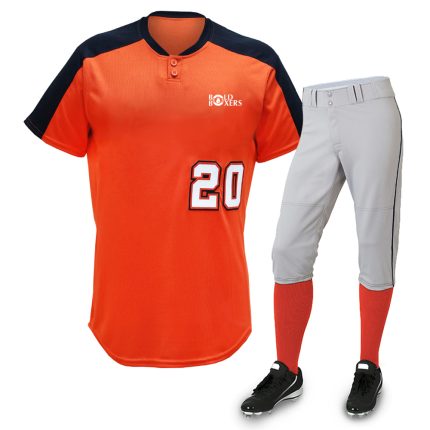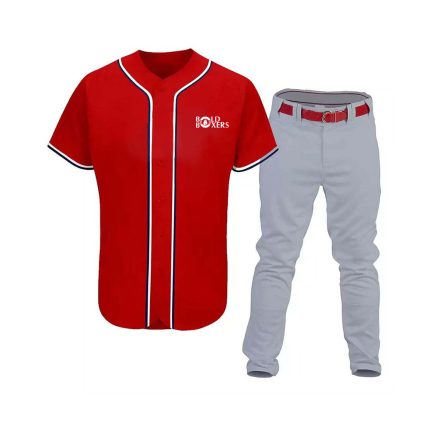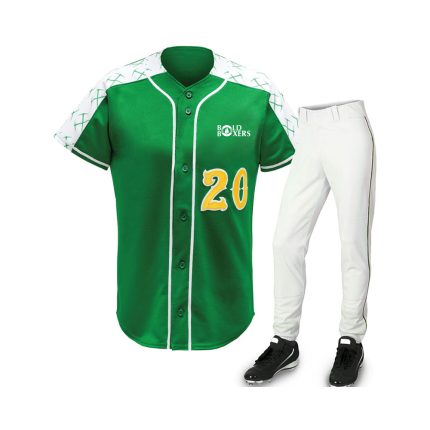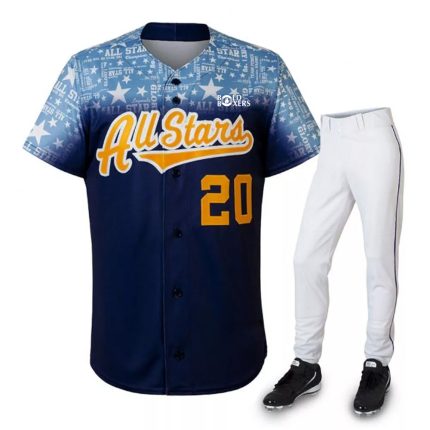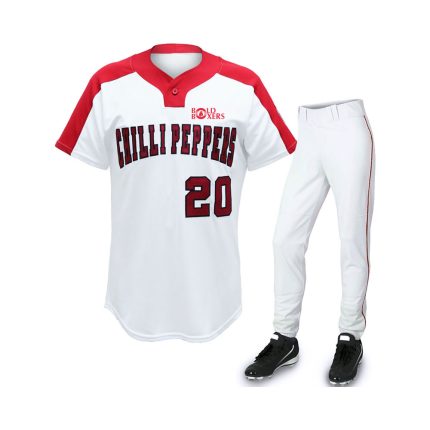Baseball Uniform
- A baseball uniform typically consists of several essential components designed for both functionality and team identification.
- The main components include a jersey, pants, cap, socks, and cleats.
- The jersey is usually made from lightweight, moisture-wicking fabric and features the team's colors, logo, and player number.
- Baseball pants are constructed from durable materials and are designed to provide freedom of movement while running, sliding, and fielding.
- The cap is an iconic part of the baseball uniform, often featuring the team's logo or emblem on the front.
- Socks are worn to complement the uniform and may feature team colors or stripes.
- Cleats are specialized shoes with spikes or studs on the sole, providing traction and stability on the field.
- Additional accessories may include belts, wristbands, and protective gear such as batting gloves or sliding shorts.
- Baseball uniforms are typically standardized across teams within a league, but variations may occur based on team tradition, sponsorship, and personal preference.
- Uniform regulations are enforced to ensure player safety and maintain consistency in appearance, including rules regarding jersey numbering, equipment standards, and uniform alterations.
Baseball Uniform
- A baseball uniform typically consists of several essential components designed for both functionality and team identification.
- The main components include a jersey, pants, cap, socks, and cleats.
- The jersey is usually made from lightweight, moisture-wicking fabric and features the team's colors, logo, and player number.
- Baseball pants are constructed from durable materials and are designed to provide freedom of movement while running, sliding, and fielding.
- The cap is an iconic part of the baseball uniform, often featuring the team's logo or emblem on the front.
- Socks are worn to complement the uniform and may feature team colors or stripes.
- Cleats are specialized shoes with spikes or studs on the sole, providing traction and stability on the field.
- Additional accessories may include belts, wristbands, and protective gear such as batting gloves or sliding shorts.
- Baseball uniforms are typically standardized across teams within a league, but variations may occur based on team tradition, sponsorship, and personal preference.
- Uniform regulations are enforced to ensure player safety and maintain consistency in appearance, including rules regarding jersey numbering, equipment standards, and uniform alterations.
Baseball Uniform
- A baseball uniform typically consists of several essential components designed for both functionality and team identification.
- The main components include a jersey, pants, cap, socks, and cleats.
- The jersey is usually made from lightweight, moisture-wicking fabric and features the team's colors, logo, and player number.
- Baseball pants are constructed from durable materials and are designed to provide freedom of movement while running, sliding, and fielding.
- The cap is an iconic part of the baseball uniform, often featuring the team's logo or emblem on the front.
- Socks are worn to complement the uniform and may feature team colors or stripes.
- Cleats are specialized shoes with spikes or studs on the sole, providing traction and stability on the field.
- Additional accessories may include belts, wristbands, and protective gear such as batting gloves or sliding shorts.
- Baseball uniforms are typically standardized across teams within a league, but variations may occur based on team tradition, sponsorship, and personal preference.
- Uniform regulations are enforced to ensure player safety and maintain consistency in appearance, including rules regarding jersey numbering, equipment standards, and uniform alterations.
Baseball Uniform
- A baseball uniform typically consists of several essential components designed for both functionality and team identification.
- The main components include a jersey, pants, cap, socks, and cleats.
- The jersey is usually made from lightweight, moisture-wicking fabric and features the team's colors, logo, and player number.
- Baseball pants are constructed from durable materials and are designed to provide freedom of movement while running, sliding, and fielding.
- The cap is an iconic part of the baseball uniform, often featuring the team's logo or emblem on the front.
- Socks are worn to complement the uniform and may feature team colors or stripes.
- Cleats are specialized shoes with spikes or studs on the sole, providing traction and stability on the field.
- Additional accessories may include belts, wristbands, and protective gear such as batting gloves or sliding shorts.
- Baseball uniforms are typically standardized across teams within a league, but variations may occur based on team tradition, sponsorship, and personal preference.
- Uniform regulations are enforced to ensure player safety and maintain consistency in appearance, including rules regarding jersey numbering, equipment standards, and uniform alterations.
Baseball Uniform
- A baseball uniform typically consists of several essential components designed for both functionality and team identification.
- The main components include a jersey, pants, cap, socks, and cleats.
- The jersey is usually made from lightweight, moisture-wicking fabric and features the team's colors, logo, and player number.
- Baseball pants are constructed from durable materials and are designed to provide freedom of movement while running, sliding, and fielding.
- The cap is an iconic part of the baseball uniform, often featuring the team's logo or emblem on the front.
- Socks are worn to complement the uniform and may feature team colors or stripes.
- Cleats are specialized shoes with spikes or studs on the sole, providing traction and stability on the field.
- Additional accessories may include belts, wristbands, and protective gear such as batting gloves or sliding shorts.
- Baseball uniforms are typically standardized across teams within a league, but variations may occur based on team tradition, sponsorship, and personal preference.
- Uniform regulations are enforced to ensure player safety and maintain consistency in appearance, including rules regarding jersey numbering, equipment standards, and uniform alterations.
Baseball Uniform
- A baseball uniform typically consists of several essential components designed for both functionality and team identification.
- The main components include a jersey, pants, cap, socks, and cleats.
- The jersey is usually made from lightweight, moisture-wicking fabric and features the team's colors, logo, and player number.
- Baseball pants are constructed from durable materials and are designed to provide freedom of movement while running, sliding, and fielding.
- The cap is an iconic part of the baseball uniform, often featuring the team's logo or emblem on the front.
- Socks are worn to complement the uniform and may feature team colors or stripes.
- Cleats are specialized shoes with spikes or studs on the sole, providing traction and stability on the field.
- Additional accessories may include belts, wristbands, and protective gear such as batting gloves or sliding shorts.
- Baseball uniforms are typically standardized across teams within a league, but variations may occur based on team tradition, sponsorship, and personal preference.
- Uniform regulations are enforced to ensure player safety and maintain consistency in appearance, including rules regarding jersey numbering, equipment standards, and uniform alterations.
Basketball Uniform
- A basketball uniform typically consists of several essential components designed for both performance and team identification.
- The main components include a jersey, shorts, and basketball shoes.
- The jersey is usually made from breathable, moisture-wicking fabric and features the team's colors, logo, and player number.
- Basketball shorts are designed for freedom of movement and are usually made from lightweight, stretchy fabric with an elastic waistband.
- Basketball shoes are specialized athletic footwear designed to provide support, stability, and traction on the court. They often feature cushioning and ankle support to reduce the risk of injury.
- Additional accessories may include wristbands, headbands, and compression gear for added support and comfort.
- Basketball uniforms are standardized across teams within a league, but variations may occur based on team tradition, sponsorship, and personal preference.
- Uniform regulations are enforced to ensure player safety and maintain consistency in appearance, including rules regarding jersey numbering, equipment standards, and uniform alterations.
Basketball Uniform
- A basketball uniform typically consists of several essential components designed for both performance and team identification.
- The main components include a jersey, shorts, and basketball shoes.
- The jersey is usually made from breathable, moisture-wicking fabric and features the team's colors, logo, and player number.
- Basketball shorts are designed for freedom of movement and are usually made from lightweight, stretchy fabric with an elastic waistband.
- Basketball shoes are specialized athletic footwear designed to provide support, stability, and traction on the court. They often feature cushioning and ankle support to reduce the risk of injury.
- Additional accessories may include wristbands, headbands, and compression gear for added support and comfort.
- Basketball uniforms are standardized across teams within a league, but variations may occur based on team tradition, sponsorship, and personal preference.
- Uniform regulations are enforced to ensure player safety and maintain consistency in appearance, including rules regarding jersey numbering, equipment standards, and uniform alterations.
Basketball Uniform
- A basketball uniform typically consists of several essential components designed for both performance and team identification.
- The main components include a jersey, shorts, and basketball shoes.
- The jersey is usually made from breathable, moisture-wicking fabric and features the team's colors, logo, and player number.
- Basketball shorts are designed for freedom of movement and are usually made from lightweight, stretchy fabric with an elastic waistband.
- Basketball shoes are specialized athletic footwear designed to provide support, stability, and traction on the court. They often feature cushioning and ankle support to reduce the risk of injury.
- Additional accessories may include wristbands, headbands, and compression gear for added support and comfort.
- Basketball uniforms are standardized across teams within a league, but variations may occur based on team tradition, sponsorship, and personal preference.
- Uniform regulations are enforced to ensure player safety and maintain consistency in appearance, including rules regarding jersey numbering, equipment standards, and uniform alterations.
Basketball Uniform
- A basketball uniform typically consists of several essential components designed for both performance and team identification.
- The main components include a jersey, shorts, and basketball shoes.
- The jersey is usually made from breathable, moisture-wicking fabric and features the team's colors, logo, and player number.
- Basketball shorts are designed for freedom of movement and are usually made from lightweight, stretchy fabric with an elastic waistband.
- Basketball shoes are specialized athletic footwear designed to provide support, stability, and traction on the court. They often feature cushioning and ankle support to reduce the risk of injury.
- Additional accessories may include wristbands, headbands, and compression gear for added support and comfort.
- Basketball uniforms are standardized across teams within a league, but variations may occur based on team tradition, sponsorship, and personal preference.
- Uniform regulations are enforced to ensure player safety and maintain consistency in appearance, including rules regarding jersey numbering, equipment standards, and uniform alterations.
Basketball Uniform
- A basketball uniform typically consists of several essential components designed for both performance and team identification.
- The main components include a jersey, shorts, and basketball shoes.
- The jersey is usually made from breathable, moisture-wicking fabric and features the team's colors, logo, and player number.
- Basketball shorts are designed for freedom of movement and are usually made from lightweight, stretchy fabric with an elastic waistband.
- Basketball shoes are specialized athletic footwear designed to provide support, stability, and traction on the court. They often feature cushioning and ankle support to reduce the risk of injury.
- Additional accessories may include wristbands, headbands, and compression gear for added support and comfort.
- Basketball uniforms are standardized across teams within a league, but variations may occur based on team tradition, sponsorship, and personal preference.
- Uniform regulations are enforced to ensure player safety and maintain consistency in appearance, including rules regarding jersey numbering, equipment standards, and uniform alterations.
Basketball Uniform
- A basketball uniform typically consists of several essential components designed for both performance and team identification.
- The main components include a jersey, shorts, and basketball shoes.
- The jersey is usually made from breathable, moisture-wicking fabric and features the team's colors, logo, and player number.
- Basketball shorts are designed for freedom of movement and are usually made from lightweight, stretchy fabric with an elastic waistband.
- Basketball shoes are specialized athletic footwear designed to provide support, stability, and traction on the court. They often feature cushioning and ankle support to reduce the risk of injury.
- Additional accessories may include wristbands, headbands, and compression gear for added support and comfort.
- Basketball uniforms are standardized across teams within a league, but variations may occur based on team tradition, sponsorship, and personal preference.
- Uniform regulations are enforced to ensure player safety and maintain consistency in appearance, including rules regarding jersey numbering, equipment standards, and uniform alterations.

